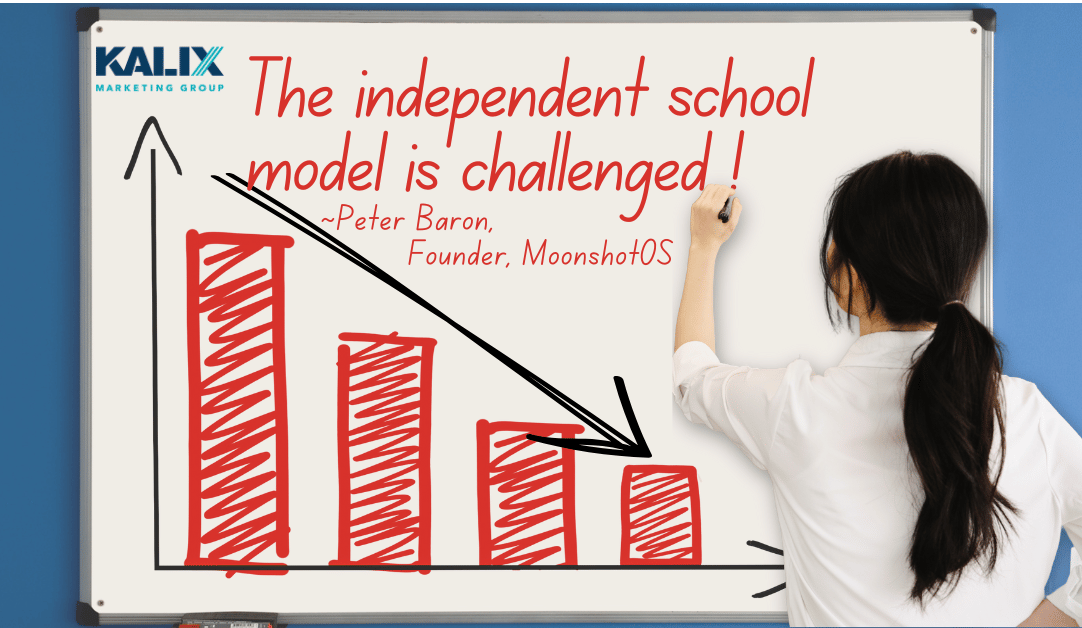One of the biggest challenges in leading an independent school today is creating a sustainable business model. Easier said than done, particularly in this post-pandemic educational environment.
To get answers, I spoke with Peter Baron, founder of MoonshotOS, a professional learning community empowering leaders to reimagine the independent school business model. Peter’s expertise in creating sustainable independent school ecosystems began when he attended broadening school at Brewster Academy. That transformative experience set him on a 20-year path to serve independent schools.
His career has included association management, product development, sales, relationship development, marketing, entrepreneurship and hosting 300-plus podcasts focused on leadership and independent school growth. Before founding MoonshotOS last summer, he was chief member relations officer for the Enrollment Management Association.
Q: Why isn’t the old model of independent schools working anymore?
A: If you look at it from a revenue distribution pie, it’s basically 79 percent of [school] revenues coming through tuition fees. The 21 percent gap needed to cover operating expenses is getting harder and harder to accomplish. Right now, [most schools] are taking a five percent endowment draw, another five percent from the annual fund, and then the last 11 percent is coming from other sources of auxiliary programs.
This revenue distribution pie fuels the promise that we make to our families. When you pay $50,000 a year, you want a transformational experience. Coming out of the COVID-19 pandemic, though, the stressors on the model are even greater.
Independent schools are very competitive right now. This is not true in every market or at the top end, but it’s true for the mid-tier down. Many regions are seeing double-digit birth declines over the last 20 years. With fewer kids, we have to be more competitive. Public schools don’t want to give up students, and there are [more options] with homeschooling, online programs, micro schools, and charter schools.
Independent schools’ strengths are to create tailored signature programs, but these programs aren’t always additive to revenue. The old revenue distribution pie can’t fully fund the promise that we’re making, so we ask our teachers to do more. The end result is burnout.
Our employment pool is Millennials and Gen Z, who have a very different relationship with work, with more requests for remote or hybrid work, which is really hard to do in independent schools. Plus, the number of college-aged students who view teaching as a career has declined. As a result, schools are losing teachers and have a shrinking candidate pool we’ve seen before.
Then there’s tightening credit. If your school recently took out any kind of line against the school, it’s significantly higher than just a couple of years ago. The cost to borrow is so much higher, which is driving increased expenses.
To me, the independent school business model is challenged, and I’ve yet to talk to a head of school who isn’t experiencing one of these stressors.
Q: Is the independent consumer changing, too?
A: Right now, schools are going through that transition regarding how they market themselves. Millennial and Gen Z parents are looking at your school through a different prism than Gen X and Baby Boomers. At the macro level, Gen X and Baby Boomers are very outcome-driven. Where is my child going to get into college? How many teachers with advanced degrees do you have? As schools, we’ve marketed to this with our college list, faculty advanced degrees, AP classes, etc., and I’d argue we’ve done this well.
But things are changing. Millennials and Gen Z tend to be more value-driven, meaning do your school’s values align with ours as a family? They are less concerned about college placement and more concerned about hearing stories from schools about students so that they can visualize their child’s success.
Q: Is creating a new business model a new phenomenon?
A: In 2019, I was at the Enrollment Management Association when we partnered with the National Business Officers Association on a project called “The Future of the Independent School Business Model.” I’ve heard some version of this comment quite a few times: “Peter, we’ve been saying that this model is challenged for 20 years, yet we’re still here.”
I’ve not heard a single head say that in the past year because everything got intensified during COVID. Right now, we are in a very different place as an industry. For the last 50 or 60 years, we’ve been pulling the same operational independent school playbook off the shelf. Now, it’s showing cracks for all the reasons (and more) that we talked about earlier.
The big question is how to iterate this business model so that we can be sustainable long term, create more access for more kids and create a great, healthy work environment for our teachers, faculty and staff.
Q: Why do heads of schools need to tackle the challenge of creating a more sustainable model?
A: I’ve interviewed over 100 heads of school about this topic. All of them are super passionate about their work and communities and have had the benefit of a good leadership ecosystem supporting them in their journey. But when I ask, “Did you receive any kind of business or entrepreneurial training?,” the answer is almost universally no. Independent schools are complex, large-scale businesses with multi-million dollar operating budgets and lots of people whose livelihoods are dependent on heads making good decisions. We have to start training younger people on the leadership ladder in business skills/thinking. We need to instill these skills over time.
Q: What does MoonshotOS do to address this challenge?
A: Empowered leaders empower their schools. They’re far better equipped to tackle the bigger problems that we’re facing right now. I want to do purposeful, impactful work with independent schools. I can’t think of anything more purposeful than helping heads of school and aspiring leaders to thrive.
MoonshotOS provides business and entrepreneurial training and iterative collaboration to create new, sustainable models together versus trying to go it alone. It’s very difficult for any one school to unpack this problem. MoonshotOS is a membership organization that discusses school sustainability and develops shared solutions. We dig into complex issues like the impact of birth rates, the hiring and retention model, managing new initiatives, organizational behavior and market analysis – topics every leader needs to know and understand. [Read Peter’s blog posts on these topics and more here.]
There is such an opportunity for independent schools. Of the 56 million K-12 students in the U.S., less than 750,000 attend National Association of Independent Schools (NAIS). We need to be part of the mindset shift that’s focused on growing our market.
Need help updating your independent school’s business model? Contact me here for a free one-on-one consultation to learn how Kalix Marketing Group can assist you.

Founder, MoonshotOS
Thank you, Peter, for sharing your thoughts about what is needed to help independent schools thrive today and into the future.
Kalix Marketing looks forward to Peter’s guest-blogging on critical topics for school leaders in the coming year.
To learn more about MoonshotOS, visit moonshotos.com or contact Peter.

